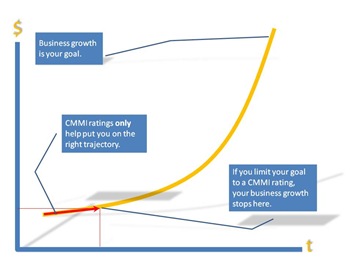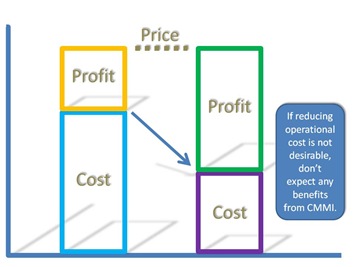Even organizations who sincerely want the benefits and improvement that comes with many well-established, well-respected practices may be undermining their own efforts.
By placing a premium on practices (agile/lean, CMMI, etc.) without the underlying values and principles, organizations risk becoming accidental level-chasers.
As an earlier post discussed, level-chasing is very deleterious and, frankly, stupid, but how and why would organizations find themselves doing so — accidentally?
They do it by focusing on practices and by putting practices in place without understanding the values and principles these practices are derived from. In fact, these practices are merely examples of what can be manifested from the values and principles and don’t represent a complete concept of any one value or principle. By worrying about practices (and often, the evidence from them), organizations fail to get the most out of the practices themselves, let alone the values and principles of the practices — which have much greater depth and utility.
Without getting into the details, it’s now a fairly well-accepted understanding that focusing on what you don’t want does not necessarily get you closer to what you do want. In fact, it’s shown that focusing on what you don’t want will more likely lead you closer to exactly what you don’t want! This translates precisely to what I see each year with many clients. If you don’t want to change your practices in unnecessary ways, focusing on practices will pull you farther from what works best for you. If you don’t want to generate artifacts for the sake of artifacts, focusing on which artifacts you do/don’t have will cause you to generate non-value-added artifacts.
At the center of this issue is that practices are just singular (or sets of) examples that typify a particular value or set of principles. When an organization performs a practice without understanding the value and principles from which the practice evolves, they often don’t know how to respond when challenged with the need to change the practice. They fear that changing the practice will negate something bigger, such as a CMMI rating. The mere concern for such ratings is an obvious red flag, but it’s sometimes not because of a need for the rating as much as it is due to not understanding the role the practice in achieving that rating.
Here’s where a favored analogy works really well:
Anyone who’s learned to play an instrument (or a sport) knows the value of practicing. Sometimes, we practice things that aren’t songs, per se, but are musical study pieces. Sometimes we practice scales and progressions. And yes, sometimes, we spend a lot of time practicing a specific piece. But the practicing of one piece doesn’t land us to be masters of a piece we’ve never seen. Practicing one piece helps us master that one piece but brings us no closer to mastering an entirely new piece.
However, what all forms of practice are, are examples of certain values and principles of playing music and learning to play an instrument. It’s the value of practice (growing our capabilities, evolving our understanding, enhancing our dexterity, etc.) that we all appreciate. With this appreciation we’re able to justify and enjoy the practice. We don’t just practice one piece in hopes of being able to master all other pieces. It’s the same as why we don’t just practice one play or one maneuver in sports as though learning this one thing will help us learn and master the other plays and maneuvers. We practice and when things change, we change the practices. When the specific application of what we’re doing changes, the practices change, but the values don’t change, and principles change very little (if at all).
A few of the values that lead organizations to being able to both perform practices appropriately as well as being able to change them when needed and still see the benefits of the practices include commitment to TQM, lean, disciplined/deliberate review, communication, transparency, learning, solid engineering, solid service management, and clearly articulated, S.M.A.R.T. goals everyone can sign-up to support.
Arguing over whether or not your practices “comply” with CMMI, or to one of many flavors of agile or lean is the wrong argument, and, leads an organization to limited benefits. It’s a fast path to being a level-chasing, pathological box-checker. Avoid this path by understanding the values and principles of the practices.
This topic will be one I’ll spend much time these next several months speaking on in many venues. Hope to see some of you at one!



 If getting leaner isn’t appealing, stay away from CMMI.
If getting leaner isn’t appealing, stay away from CMMI. On the other hand, what can we consultants and appraisers do when executives willingly take the “ratings over growth” route? When executives are not willing to stand up for what’s best for the business? When the executives are not motivated to pursue operational excellence? At the same time, we’ve all been using the wrong language with CMMI. Who the heck wants to hear about “process improvement”?!? That’s a lot like wanting to hear “you need to go on a diet and get more exercise”. Who wants that?
On the other hand, what can we consultants and appraisers do when executives willingly take the “ratings over growth” route? When executives are not willing to stand up for what’s best for the business? When the executives are not motivated to pursue operational excellence? At the same time, we’ve all been using the wrong language with CMMI. Who the heck wants to hear about “process improvement”?!? That’s a lot like wanting to hear “you need to go on a diet and get more exercise”. Who wants that?

